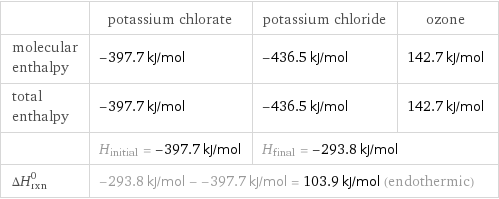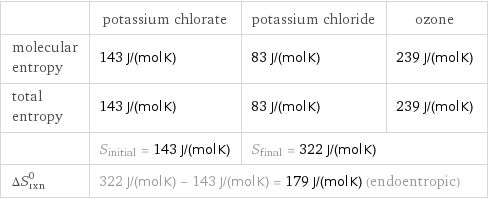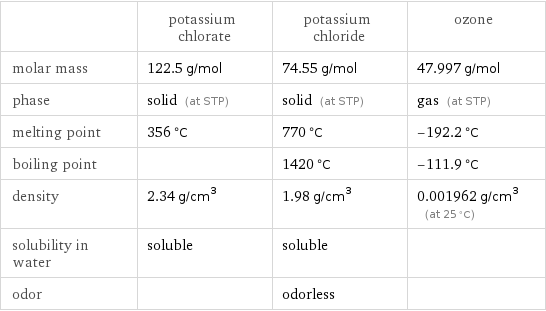Input interpretation

KClO_3 potassium chlorate ⟶ KCl potassium chloride + O_3 ozone
Balanced equation

Balance the chemical equation algebraically: KClO_3 ⟶ KCl + O_3 Add stoichiometric coefficients, c_i, to the reactants and products: c_1 KClO_3 ⟶ c_2 KCl + c_3 O_3 Set the number of atoms in the reactants equal to the number of atoms in the products for Cl, K and O: Cl: | c_1 = c_2 K: | c_1 = c_2 O: | 3 c_1 = 3 c_3 Since the coefficients are relative quantities and underdetermined, choose a coefficient to set arbitrarily. To keep the coefficients small, the arbitrary value is ordinarily one. For instance, set c_1 = 1 and solve the system of equations for the remaining coefficients: c_1 = 1 c_2 = 1 c_3 = 1 Substitute the coefficients into the chemical reaction to obtain the balanced equation: Answer: | | KClO_3 ⟶ KCl + O_3
Structures

⟶ +
Names

potassium chlorate ⟶ potassium chloride + ozone
Reaction thermodynamics
Enthalpy

| potassium chlorate | potassium chloride | ozone molecular enthalpy | -397.7 kJ/mol | -436.5 kJ/mol | 142.7 kJ/mol total enthalpy | -397.7 kJ/mol | -436.5 kJ/mol | 142.7 kJ/mol | H_initial = -397.7 kJ/mol | H_final = -293.8 kJ/mol | ΔH_rxn^0 | -293.8 kJ/mol - -397.7 kJ/mol = 103.9 kJ/mol (endothermic) | |
Gibbs free energy

| potassium chlorate | potassium chloride | ozone molecular free energy | -296.3 kJ/mol | -408.5 kJ/mol | 163.2 kJ/mol total free energy | -296.3 kJ/mol | -408.5 kJ/mol | 163.2 kJ/mol | G_initial = -296.3 kJ/mol | G_final = -245.3 kJ/mol | ΔG_rxn^0 | -245.3 kJ/mol - -296.3 kJ/mol = 51 kJ/mol (endergonic) | |
Entropy

| potassium chlorate | potassium chloride | ozone molecular entropy | 143 J/(mol K) | 83 J/(mol K) | 239 J/(mol K) total entropy | 143 J/(mol K) | 83 J/(mol K) | 239 J/(mol K) | S_initial = 143 J/(mol K) | S_final = 322 J/(mol K) | ΔS_rxn^0 | 322 J/(mol K) - 143 J/(mol K) = 179 J/(mol K) (endoentropic) | |
Equilibrium constant
![Construct the equilibrium constant, K, expression for: KClO_3 ⟶ KCl + O_3 Plan: • Balance the chemical equation. • Determine the stoichiometric numbers. • Assemble the activity expression for each chemical species. • Use the activity expressions to build the equilibrium constant expression. Write the balanced chemical equation: KClO_3 ⟶ KCl + O_3 Assign stoichiometric numbers, ν_i, using the stoichiometric coefficients, c_i, from the balanced chemical equation in the following manner: ν_i = -c_i for reactants and ν_i = c_i for products: chemical species | c_i | ν_i KClO_3 | 1 | -1 KCl | 1 | 1 O_3 | 1 | 1 Assemble the activity expressions accounting for the state of matter and ν_i: chemical species | c_i | ν_i | activity expression KClO_3 | 1 | -1 | ([KClO3])^(-1) KCl | 1 | 1 | [KCl] O_3 | 1 | 1 | [O3] The equilibrium constant symbol in the concentration basis is: K_c Mulitply the activity expressions to arrive at the K_c expression: Answer: | | K_c = ([KClO3])^(-1) [KCl] [O3] = ([KCl] [O3])/([KClO3])](../image_source/58d8072fbb2970959443b8f26a4391f5.png)
Construct the equilibrium constant, K, expression for: KClO_3 ⟶ KCl + O_3 Plan: • Balance the chemical equation. • Determine the stoichiometric numbers. • Assemble the activity expression for each chemical species. • Use the activity expressions to build the equilibrium constant expression. Write the balanced chemical equation: KClO_3 ⟶ KCl + O_3 Assign stoichiometric numbers, ν_i, using the stoichiometric coefficients, c_i, from the balanced chemical equation in the following manner: ν_i = -c_i for reactants and ν_i = c_i for products: chemical species | c_i | ν_i KClO_3 | 1 | -1 KCl | 1 | 1 O_3 | 1 | 1 Assemble the activity expressions accounting for the state of matter and ν_i: chemical species | c_i | ν_i | activity expression KClO_3 | 1 | -1 | ([KClO3])^(-1) KCl | 1 | 1 | [KCl] O_3 | 1 | 1 | [O3] The equilibrium constant symbol in the concentration basis is: K_c Mulitply the activity expressions to arrive at the K_c expression: Answer: | | K_c = ([KClO3])^(-1) [KCl] [O3] = ([KCl] [O3])/([KClO3])
Rate of reaction
![Construct the rate of reaction expression for: KClO_3 ⟶ KCl + O_3 Plan: • Balance the chemical equation. • Determine the stoichiometric numbers. • Assemble the rate term for each chemical species. • Write the rate of reaction expression. Write the balanced chemical equation: KClO_3 ⟶ KCl + O_3 Assign stoichiometric numbers, ν_i, using the stoichiometric coefficients, c_i, from the balanced chemical equation in the following manner: ν_i = -c_i for reactants and ν_i = c_i for products: chemical species | c_i | ν_i KClO_3 | 1 | -1 KCl | 1 | 1 O_3 | 1 | 1 The rate term for each chemical species, B_i, is 1/ν_i(Δ[B_i])/(Δt) where [B_i] is the amount concentration and t is time: chemical species | c_i | ν_i | rate term KClO_3 | 1 | -1 | -(Δ[KClO3])/(Δt) KCl | 1 | 1 | (Δ[KCl])/(Δt) O_3 | 1 | 1 | (Δ[O3])/(Δt) (for infinitesimal rate of change, replace Δ with d) Set the rate terms equal to each other to arrive at the rate expression: Answer: | | rate = -(Δ[KClO3])/(Δt) = (Δ[KCl])/(Δt) = (Δ[O3])/(Δt) (assuming constant volume and no accumulation of intermediates or side products)](../image_source/d629b25d70117ffedb0b8cf0ea9e0912.png)
Construct the rate of reaction expression for: KClO_3 ⟶ KCl + O_3 Plan: • Balance the chemical equation. • Determine the stoichiometric numbers. • Assemble the rate term for each chemical species. • Write the rate of reaction expression. Write the balanced chemical equation: KClO_3 ⟶ KCl + O_3 Assign stoichiometric numbers, ν_i, using the stoichiometric coefficients, c_i, from the balanced chemical equation in the following manner: ν_i = -c_i for reactants and ν_i = c_i for products: chemical species | c_i | ν_i KClO_3 | 1 | -1 KCl | 1 | 1 O_3 | 1 | 1 The rate term for each chemical species, B_i, is 1/ν_i(Δ[B_i])/(Δt) where [B_i] is the amount concentration and t is time: chemical species | c_i | ν_i | rate term KClO_3 | 1 | -1 | -(Δ[KClO3])/(Δt) KCl | 1 | 1 | (Δ[KCl])/(Δt) O_3 | 1 | 1 | (Δ[O3])/(Δt) (for infinitesimal rate of change, replace Δ with d) Set the rate terms equal to each other to arrive at the rate expression: Answer: | | rate = -(Δ[KClO3])/(Δt) = (Δ[KCl])/(Δt) = (Δ[O3])/(Δt) (assuming constant volume and no accumulation of intermediates or side products)
Chemical names and formulas

| potassium chlorate | potassium chloride | ozone formula | KClO_3 | KCl | O_3 Hill formula | ClKO_3 | ClK | O_3 name | potassium chlorate | potassium chloride | ozone
Substance properties

| potassium chlorate | potassium chloride | ozone molar mass | 122.5 g/mol | 74.55 g/mol | 47.997 g/mol phase | solid (at STP) | solid (at STP) | gas (at STP) melting point | 356 °C | 770 °C | -192.2 °C boiling point | | 1420 °C | -111.9 °C density | 2.34 g/cm^3 | 1.98 g/cm^3 | 0.001962 g/cm^3 (at 25 °C) solubility in water | soluble | soluble | odor | | odorless |
Units
